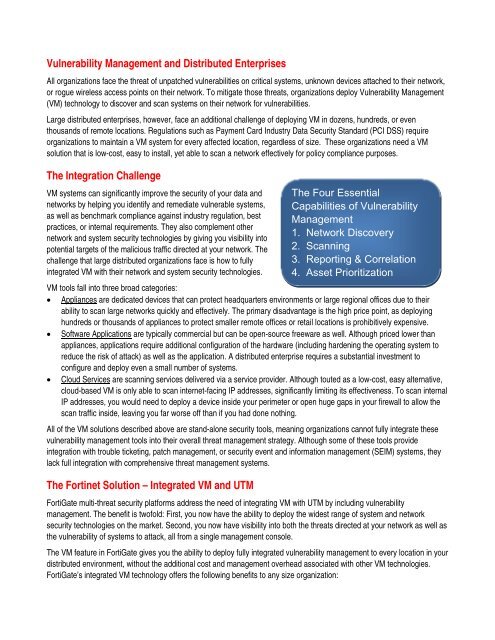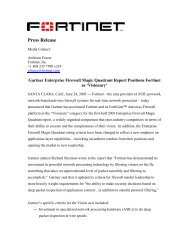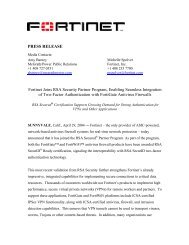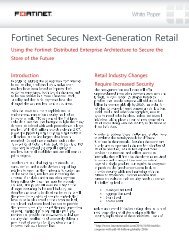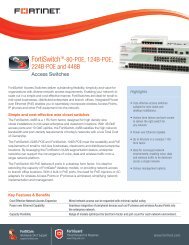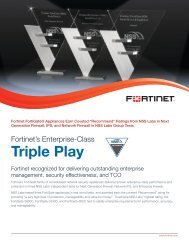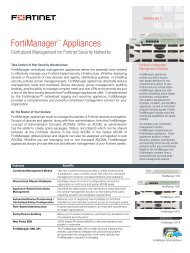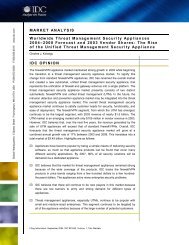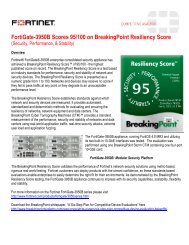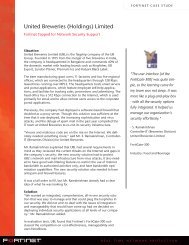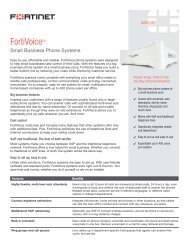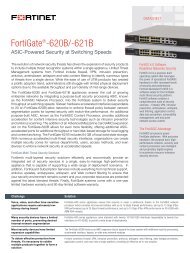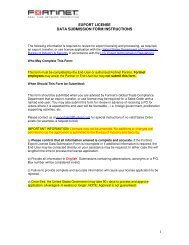Vulnerability Management for the Distributed Enterprise - Fortinet
Vulnerability Management for the Distributed Enterprise - Fortinet
Vulnerability Management for the Distributed Enterprise - Fortinet
Create successful ePaper yourself
Turn your PDF publications into a flip-book with our unique Google optimized e-Paper software.
<strong>Vulnerability</strong> <strong>Management</strong> and <strong>Distributed</strong> <strong>Enterprise</strong>s<br />
All organizations face <strong>the</strong> threat of unpatched vulnerabilities on critical systems, unknown devices attached to <strong>the</strong>ir network,<br />
or rogue wireless access points on <strong>the</strong>ir network. To mitigate those threats, organizations deploy <strong>Vulnerability</strong> <strong>Management</strong><br />
(VM) technology to discover and scan systems on <strong>the</strong>ir network <strong>for</strong> vulnerabilities.<br />
Large distributed enterprises, however, face an additional challenge of deploying VM in dozens, hundreds, or even<br />
thousands of remote locations. Regulations such as Payment Card Industry Data Security Standard (PCI DSS) require<br />
organizations to maintain a VM system <strong>for</strong> every affected location, regardless of size. These organizations need a VM<br />
solution that is low-cost, easy to install, yet able to scan a network effectively <strong>for</strong> policy compliance purposes.<br />
The Integration Challenge<br />
VM systems can significantly improve <strong>the</strong> security of your data and<br />
networks by helping you identify and remediate vulnerable systems,<br />
as well as benchmark compliance against industry regulation, best<br />
practices, or internal requirements. They also complement o<strong>the</strong>r<br />
network and system security technologies by giving you visibility into<br />
potential targets of <strong>the</strong> malicious traffic directed at your network. The<br />
challenge that large distributed organizations face is how to fully<br />
integrated VM with <strong>the</strong>ir network and system security technologies.<br />
VM tools fall into three broad categories:<br />
• Appliances are dedicated devices that can protect headquarters environments or large regional offices due to <strong>the</strong>ir<br />
ability to scan large networks quickly and effectively. The primary disadvantage is <strong>the</strong> high price point, as deploying<br />
hundreds or thousands of appliances to protect smaller remote offices or retail locations is prohibitively expensive.<br />
• Software Applications are typically commercial but can be open-source freeware as well. Although priced lower than<br />
appliances, applications require additional configuration of <strong>the</strong> hardware (including hardening <strong>the</strong> operating system to<br />
reduce <strong>the</strong> risk of attack) as well as <strong>the</strong> application. A distributed enterprise requires a substantial investment to<br />
configure and deploy even a small number of systems.<br />
• Cloud Services are scanning services delivered via a service provider. Although touted as a low-cost, easy alternative,<br />
cloud-based VM is only able to scan internet-facing IP addresses, significantly limiting its effectiveness. To scan internal<br />
IP addresses, you would need to deploy a device inside your perimeter or open huge gaps in your firewall to allow <strong>the</strong><br />
scan traffic inside, leaving you far worse off than if you had done nothing.<br />
All of <strong>the</strong> VM solutions described above are stand-alone security tools, meaning organizations cannot fully integrate <strong>the</strong>se<br />
vulnerability management tools into <strong>the</strong>ir overall threat management strategy. Although some of <strong>the</strong>se tools provide<br />
integration with trouble ticketing, patch management, or security event and in<strong>for</strong>mation management (SEIM) systems, <strong>the</strong>y<br />
lack full integration with comprehensive threat management systems.<br />
The <strong>Fortinet</strong> Solution – Integrated VM and UTM<br />
The Four Essential<br />
Capabilities of <strong>Vulnerability</strong><br />
<strong>Management</strong><br />
1. Network Discovery<br />
2. Scanning<br />
3. Reporting & Correlation<br />
4. Asset Prioritization<br />
FortiGate multi-threat security plat<strong>for</strong>ms address <strong>the</strong> need of integrating VM with UTM by including vulnerability<br />
management. The benefit is twofold: First, you now have <strong>the</strong> ability to deploy <strong>the</strong> widest range of system and network<br />
security technologies on <strong>the</strong> market. Second, you now have visibility into both <strong>the</strong> threats directed at your network as well as<br />
<strong>the</strong> vulnerability of systems to attack, all from a single management console.<br />
The VM feature in FortiGate gives you <strong>the</strong> ability to deploy fully integrated vulnerability management to every location in your<br />
distributed environment, without <strong>the</strong> additional cost and management overhead associated with o<strong>the</strong>r VM technologies.<br />
FortiGate’s integrated VM technology offers <strong>the</strong> following benefits to any size organization:


